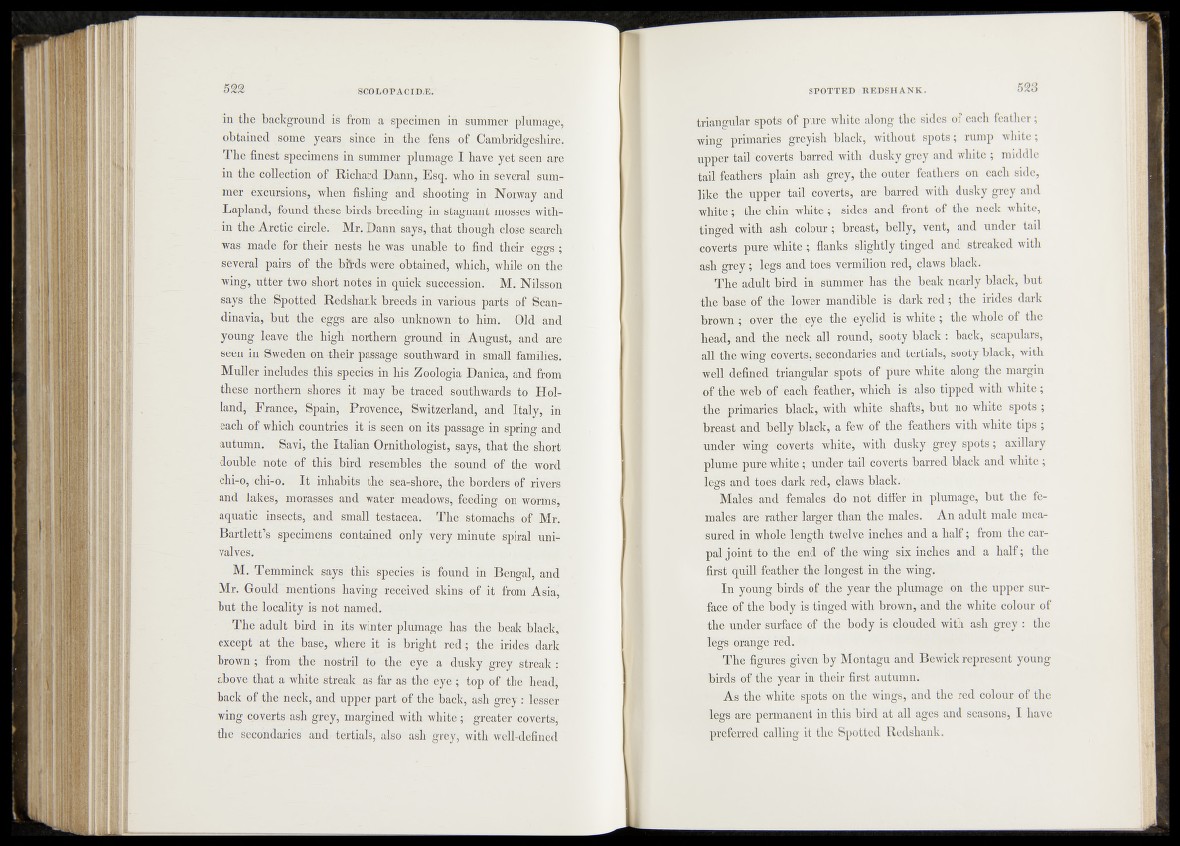
in the background is from a specimen in summer plumage,
obtained some years, since in .th e .fens of Cambridgeshire.
The finest’specimens in summerr.plumage. I have yet seen are
in the collection of Richard Dann., Esq. who in several summer
excursions, when fishing and shooting in Norway and
Lapland, found these birds breeding« in- stagnant mosses within
the Arctic circle. Mr. Dann says^that though close search
was made "for their nests he was unable to finddheir eOnos s ":
several pairs of the bfrds were obtained;'which, while on the
wing, utter two short notes in quick-succession. Mr Nilsson
says the Spotted Redshank breeds-in various parts of Scandinavia,
but the. eggs are also «unknown'4$ him. Old and
young leave the high northern ground in August, and are
seen in Sweden on -their passage southward in - small families;
Muller includesJhis specie^'in his Zoologia Banina, and from
these northern shores it may be .traced southwards to Holland,
France, Spain, Provence, Switzerland;' and Italy,'-5 in
each-nf which countries it is seen' on its'passage in spring and
autumn.- Savi, the Italian Ornithologist, says, that the short
double note of this bird resembles -the ■ sdund ofr the word
chhq^iAi-®.' It-inhabits t^e sea-shore, .the borders of rivers,
and lakes, morasses and w^ter nteadowg^feeding on worms;
aquatic insect’s,.and small-testacea-. The stomachs‘of Mr.
Bartlett’s specimens; Contained only Ivery minute- spiral univalves.^
M. Temminck says’ this species’is found in Bengal, and
Mr. Gould mentions having-received skins of it from Asiaj
but .the locality is not named.
The adult bird in its winter plumage has-the beak black,
except at the base, where it is bright re d ; the irides dark
brown; from the nostril to .-the' eye a dusky .grey streak :
above1 that a white streak as far as the eye ; top of the head,
back of the neck, and upper part ofihe back, ash grey : lesser
wing coverts ash grey, margined with white; greater' coverts,
the secondaries and» tertials, also ash grey,- with well-defined
triangular spots of pure white along the sides of each feather;
wing primaries greyish black, without spots; rump white;
upper tail ho verts barred with dusky grey and white ; middle
tail feathers plain ash grey, the outer feathers on each side,
like the upper tail coverts, are barred with dusky grey and
white; the chin white; sides and front of the neck white,
tinged with ash colour; breast,' belly, vent, and under tail
coverts pure white ; flanks slightly tinged and streaked with
ash grey; legs and toes vermilion red, claws black.
The adult bird in summer has the beak nearly black, but
the base of the lower mandible is dark red ; the irides dark
brown ;..over the^eye,*.the .'eyelid is white ; the whole of the
head,* and the ne^k all round," sqoty black : back, scapulars,
all the wing.coverts, secondaries and tertials, sooty black, with
well defined triangular spots of pure white along the margin
of-the web of each feather, which is also tipped with white;
the primaries black, with white shafts, but no white spots;
breast and belly black, a -few of the feathers with white tips ;
under wing coverts white, with dusky grey spots; axillary
plume pure white ;i under tail coverts barred black and white;
legs and toes dark red, claws black.;
, Males and females do not differ in plumage, but the females
are rather larger than the males. An adult male measured
in whole"!ength twelve inches and a half; from the carpal
joint to the end of the wing six inches and a half; the
first quill feather the longest in the wing.
In young'birds of the year the plumage on the upper surface
of the body is tinged with brown, and the white colour of
the under surface of the body is clouded with ash grey : the
legs orange red.
The figures given by Montagu and Bewick represent young
birds of the year in their first autumn.
As the white spots on the wings, and the red colour of the
legs are permanent in this bird at all ages and seasons, I have
preferred calling it the Spotted Redshank.